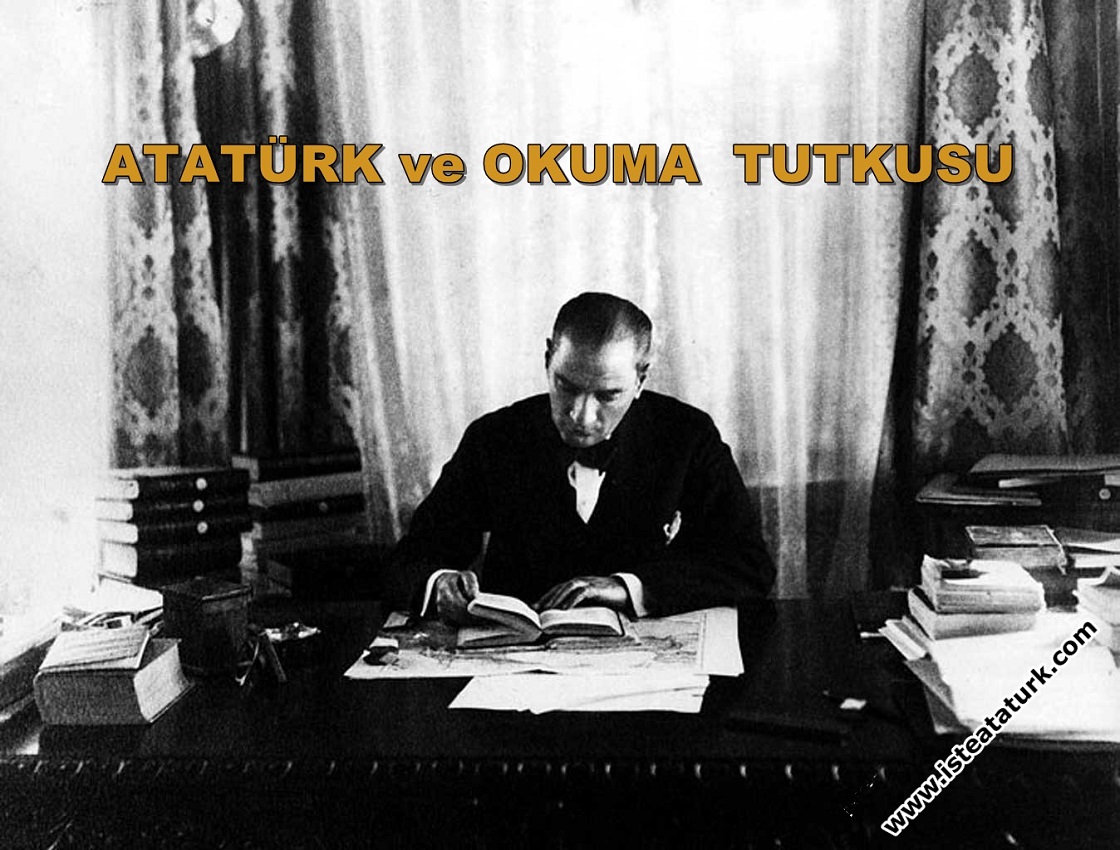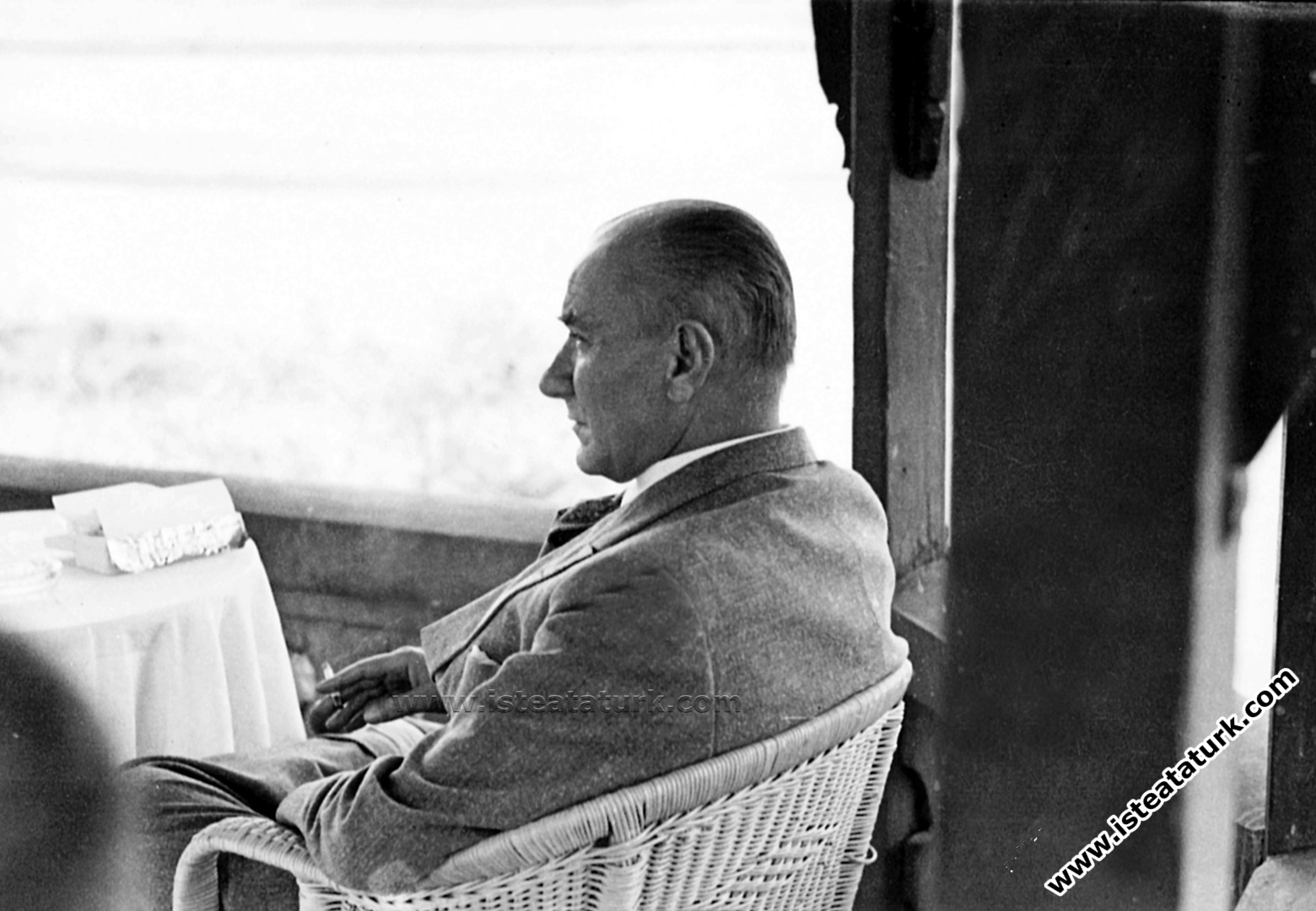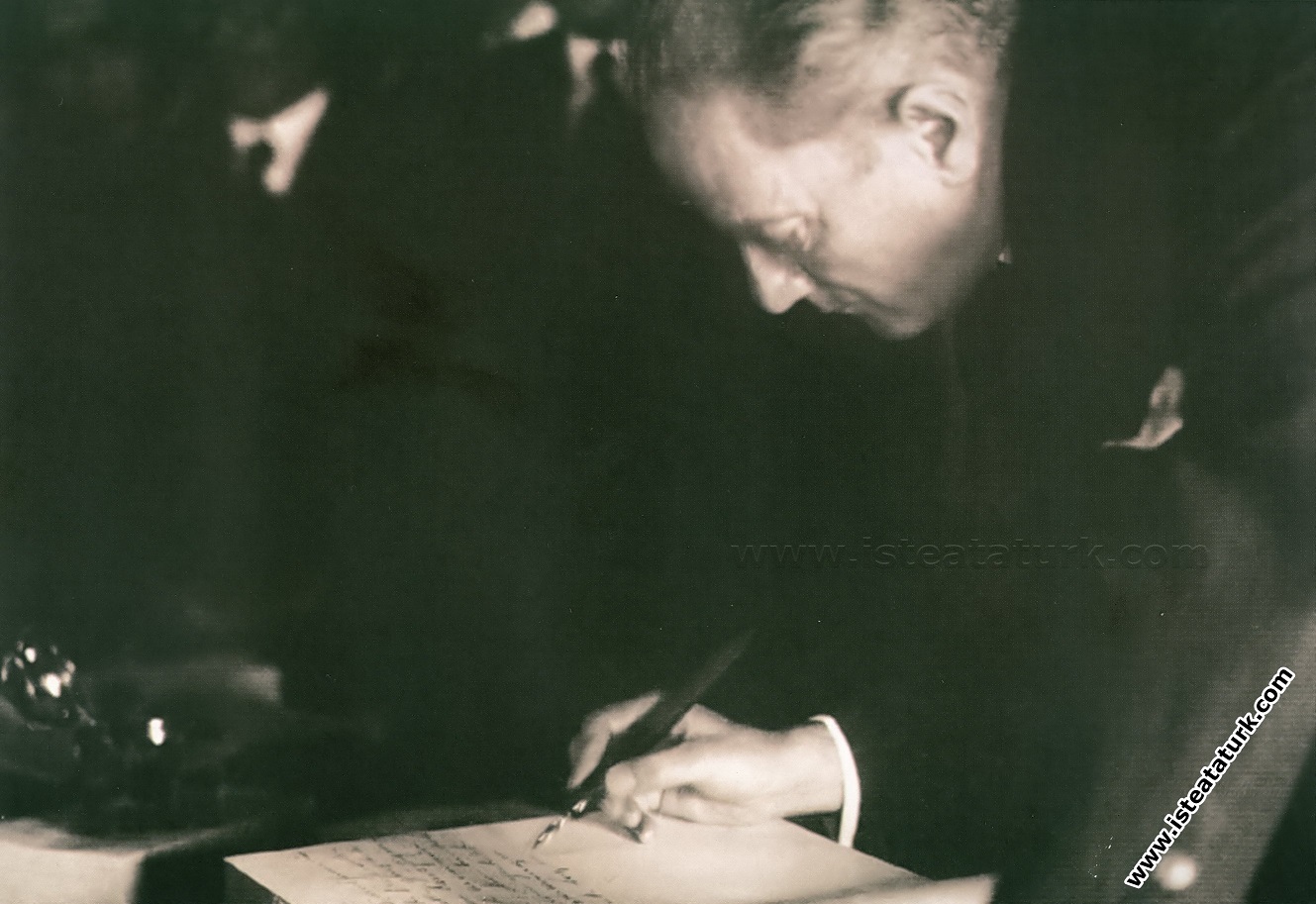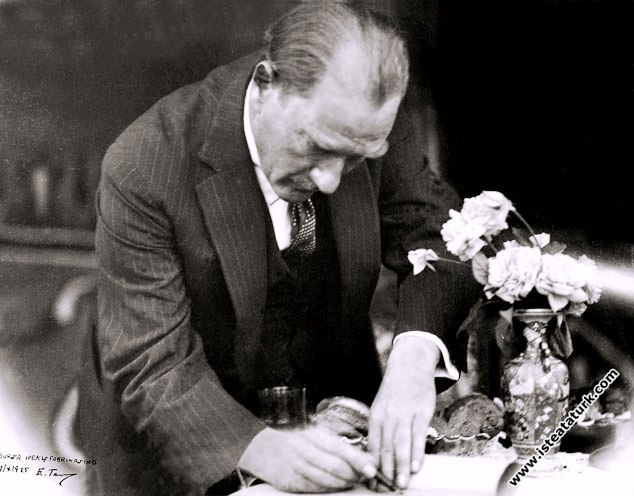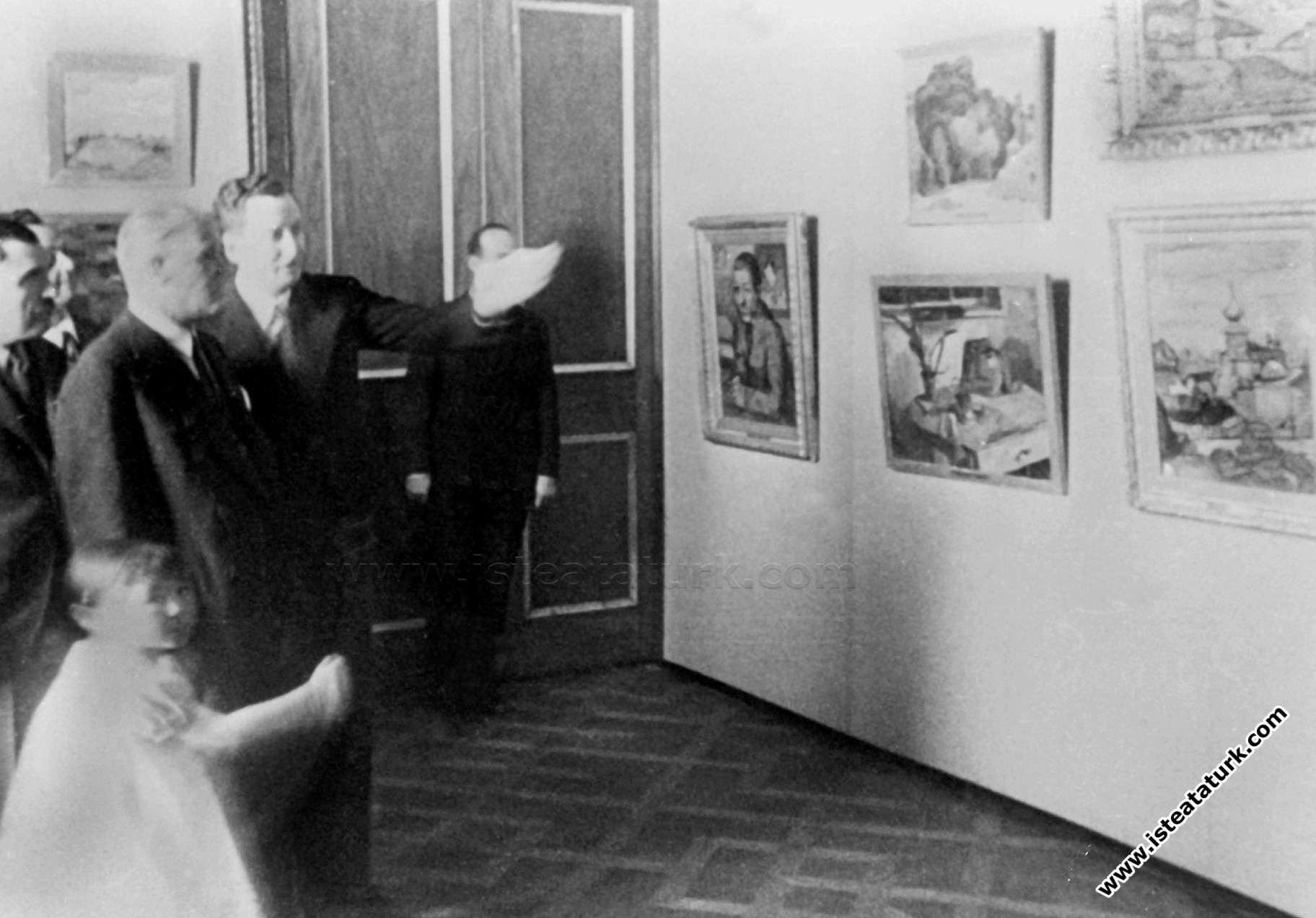
Atatürk, History Teaching and Museums
Character Size
Atatürk, History Teaching and Museums
Atatürk, History Teaching and Museums
In the 1920s, Atatürk's speeches and views on education were handled by educators such as Mustafa Rahmi and Mehmet Emin Erişirgil as a guide in determining the goals of the Turkish education system. During the period of İsmail Safa Bey (Özler), Minister of Education, these views were declared as the Educational Pact. These views not only drew the framework of national education, but also influenced school history programs as the most important tool of citizenship transfer and political socialization. In that case, in order to understand the content of the Republican era history programs and the teaching methods they suggested, it is necessary to know Atatürk's views and actions on the subject. First of all, it is seen that Atatürk adopted the contemporary history pedagogy. This adoption As well as it envisages that the content of history programs be national and that history textbooks be written from a national point of view (because contemporary education is national education.), it also envisages the diversity of historical presentation methods [history writing and teaching based on documents, education with maps, question-answer based on divergent questions. method, history field trips, drama activity, use of museums] was necessary. How did Atatürk present his history lessons to young people in this study? Starting from this question, attention will be drawn to Atatürk's pedagogical knowledge and contemporary methods of teaching history to children and young people. history field trips, drama activity, use of museums] made it necessary. How did Atatürk present his history lessons to young people in this study? Starting from this question, attention will be drawn to Atatürk's pedagogical knowledge and contemporary methods of teaching history to children and young people. history field trips, drama activity, use of museums] made it necessary. How did Atatürk present his history lessons to young people in this study? Starting from this question, attention will be drawn to Atatürk's pedagogical knowledge and contemporary methods of teaching history to children and young people.
1. History Program and Textbook Matter
Atatürk could only really deal with the restructuring of history programs and the issues of history textbooks related to history teaching after 1928. Famous educator İhsan Sungu stated the following while criticizing the history books in a report he submitted to the Ministry of Education of the Turkish Grand National Assembly dated 17.12.1922;
“If we look at our recitation books, which states that zakat is calculated as one-tenth in Islam, a history book translated to be taught in our schools, and that the fastest way to study about Assyrians is to visit the Louvre museum, it is not only an interpreter for the spirit of this nation, but for the soul of this nation. The smell of translation, the air of a neighborhood completely foreign to us, is felt...” (1923:21).
According to Kazım Nami Duru, many textbooks prepared according to the secondary school curriculum were translated from English or German and were not suitable for the living conditions of Turkey. Moreover, unlike the primary and secondary school programs, high school programs were the continuation of the old sultani programs and were the French programs that had come to the fore in the Republic. These programs were made by subject matter experts, not by education experts. These experts gave more importance to their fields of expertise. History programs also got their share from this situation. In 1924, in articles published in educational journals, it was suggested that history programs should be "consolidated" around national history, as in Germany. For example, Ahmet Tevfik wrote about Germany in an article he wrote in Muallimler Magazine. He pointed out that in the classical history books published in Turkey, historical events were gathered around national history. It is within this framework that Fuat Köprülü's book titled National History, written in 1923 for 4th and 5th grade primary schools, should be considered.
Atatürk's first close interest in history programs showed itself during his trip to Trabzon in 1924 and 1925. When history teacher Rıfat Bey complained about the lack of program hours at a teachers' meeting in Trabzon high school, he talked for two hours on this subject and laid the first principles of the Turkish history thesis (Egeli, 1959:65). It is understood that Atatürk read by underlining some parts of the sections related to history in the primary education program put into effect in 1926. It is noteworthy that among the objectives of the primary school history lesson, Atatürk specifically marked the sentence "To show the children unique samples by describing the life and movements of great people" (Tüfekçi, 1983:332).
In 1927, a radical change was made in the history programs. The aim of this change was to make Turkish history the axis and to teach (Hasan Âli Yücel, 1946: 286). Between 1923 and 1930, the books of historians such as Ahmet Refik, Fuat Köprülü, İhsan Şerif and Ali Reşad were taught in schools. These writers, in accordance with the spirit of the Republican administration, II. They corrected and reprinted the textbooks used during the Second Constitutional Monarchy according to the program changes. After 1928, Atatürk personally dealt with the issue of the content of his history programs. This year, Afetinan told Atatürk that a French geography book he read had written about the claim that Turks belonged to the yellow race and were considered a second-class human being. Thereupon, Atatürk decided to dwell on this issue (Karal, 1988:160). Ataturk, While he was dealing with history programs and textbooks, he wanted some scientific history books to be translated into Turkish. Since Atatürk gave importance to the role played by the Turks in world history in HG Wells's book, The Main Lines of the World History, he had it translated quickly, with the desire of Turkish intellectuals to read it. While the budget of the Ministry was being discussed in the TBM Assembly on May 18, 1930, Deputy of Education Cemal Hüsnü Bey (Gümüşhane Deputy) said that the Education and Training Committee had arranged the programs, but the programs were made by a committee consisting of Darülfünun. He states that the Turkish historical program was also prepared by Yusuf Akçura and that the mandate tried to implement it. When it comes to history teaching in high schools and secondary schools, History books written according to the Main Lines of Turkish History come to mind. As it is known, this book was prepared by the Turkish History Committee established under the Turkish Hearth. In this delegation, there were Afetinan, Mehmet Tevfik, Samih Rifat, Yusuf Akçura, Reşit Galip, Hasan Cemil, Sadri Maksudi, Şemseddin, Vasif and Yusuf Ziya Beys. In 1931, 30,000 copies of this book were printed and distributed to schools by the Ministry of National Education. Again, in the summer of the same year, 4-volume high school history textbooks were prepared by a team within the body of the Turkish History Research Society. Hasan Âli Yücel also states that this change in the history programs in 1930 was by the order of Atatürk, and that the program was organized according to the 4-volume history books dictated by the Turkish History Research Society (Hasan Âli Yücel, 1946: 287). This statement of Hasan Âli Yücel also explains why secondary and high school history programs do not have pedagogical parts such as a target, teaching methods, as in primary schools. At the 1st Turkish History Congress held in 1932, Ferit Bey, the History-Geography teacher of Konya Girls' Secondary School, claimed that these books were insufficient for the teachers and too much for the students. İhsan Sungu, who is the Head of Education and Discipline, argued that these books are detailed and not higher than the student level for the first-stage student. According to Sungu (1932:282-283), most of these students will not go to a higher school, it is not desirable for children to leave school without learning the general lines of Turkish History. The second point Sungu emphasizes is that there is no history book published with new letters. Moreover, every name entered in the book, The date and number do not need to be taught to the child. However, having them in the books would be beneficial for historical studies. As a matter of fact, in 1933, since it was seen that the history textbooks written for high schools would be difficult to follow and these books were heavy, new history textbooks were started to be printed for secondary schools, and it was foreseen that they would be completed in the 1934 academic year (Reşit Galip, 1946:119). On this subject, Reşit Galip states the following: It was foreseen to be trained in the 1934 academic year (Reşit Galip, 1946:119). On this subject, Reşit Galip says: It was foreseen to be trained in the 1934 academic year (Reşit Galip, 1946:119). On this subject, Reşit Galip states the following:
"Since it defends a national thesis, it is obligatory to have these books taught in those schools, since our new historical point of view is based on the new truths of science." (Reşit Galip, 1946:119).
During the 1943 Education Council, these history textbooks, which were written for secondary and high schools in the history teaching section in the 1930s, were discussed and it was emphasized that they were not suitable for the level of children. In this context, Gazi Pedagogy Teacher Ziya Talat (Çağıl) expressed Piaget's views on child psychology. The importance of using museums and antiques in teaching history to children who are at the stage of concrete thinking was once again brought to the agenda (II. Education Council, 1943:233).
In the 1930s and 40s, there was a crisis of textbook absence, especially in higher education. In this context, though, Hasan Âli Yücel claimed that teachers in other and advanced countries print their own grades and analyze them, and that the university is not limited to existing and fixed information, and that new studies and research should be reflected to the students (Hasan Âli Yücel, 1946: 293). In those years, it is seen that the teachers in the history department made such notes to their students. For example, the late Dr. I came across such notes by Mükrimin Halil Yınanç and İsmail Hakkı Uzunçarşılı in Hüseyin Dağtekin's library. These historians later published the lecture notes as a book.
As it can be understood from the above statements, Atatürk especially focused on the problem of history programs and textbooks after 1928. The short duration of the compulsory education and the limited resources due to the letter revolution caused the children to encounter a very loaded history program and history textbooks for that day.
Today, this problem has been partially overcome by increasing the compulsory education period to 8 years. Increasing compulsory education to 12 years in Turkey, as in European countries, will undoubtedly facilitate a balanced distribution of history curriculum subjects according to children's psychological ages.
2. Efforts to Diversify History Lesson Offering
In the first years of the Republic, aside from the directives on teaching history in history programs, it is seen that Atatürk diversified the presentation of the history course with his own actions.
2.1. Documentary Historiography and Teaching
Document in historical research; It can be written and visual as well as objects presented by museums and historical places. However, only written documents come to mind when history is mentioned in Turkey. At first glance, it can be thought that the Ottoman archive has not been classified yet. In reality, the reason is more methodological. With the Constitutional Monarchy in Turkey, a Seignobos Reign began in Ottoman schools. The history teachers of the Darülfünun mostly translated the French history books, especially the pantry of Langlois and Seignobos. 100 years ago, two French historians, CV Langlois and C. Seignobos, in their Introduction to History Studies, claimed that historiography was mainly based on documentary evidence, and adopted an approach that "without documents, history does not exist". Although today it is desired to bring a new dimension to historiography with social historiography and oral historiography approaches, Seignobos type historiography in Turkey maintains its importance as the most common historiography understanding by professional historians. On the other hand, it is obvious that Atatürk was sensitive to all kinds of documents. Atatürk tried to prevent the destruction of all kinds of objects belonging to Turkish history and culture by establishing the ethnography museum and the Revolution museums as well as the archeology museums.
7.4. In an interview with Yunus Nadi Bey in 1924, Atatürk said that in order to understand whether a historical work is in accordance with the facts, it is necessary to look at the sources and documents on which it is based, but until now, the misfortune of historians is that it is based on the words of some praisers or selfish people, and he went to the War of Independence. He stated that he would write his memoirs based on the documents he collected (Atatürk's Discourses and Statements, Vol. V, p.101). As a matter of fact, he wrote his work called Nutuk. This interview is important in terms of showing Atatürk's understanding of history based on written documents.
Atatürk also gave importance to photographs and film type documents and tried to leave many visual documents in the history education of future generations. Esat Nedim, Atatürk's photographer from the Teachers' School, took a lot of Atatürk photos that will improve the visual memory of young people. It is possible to encounter such visual documents in museums about the War of Independence, the Republic and Atatürk. History teachers should be equipped to work with such material.
2.2. History Education with a Map
This article was inspired by a photograph showing Atatürk at the beginning of the historical map. By many subject matter experts, it is not the presence of the map in this photograph, but its content; rightly, it was examined in terms of the Turkish history thesis and the migration routes of the Turks. When this photograph is viewed from the perspective of a history educator; photography alone can be interpreted as an indication of the importance of the map as a history lesson tool by Atatürk. General Galip Pasinler, who, like Atatürk, studied at the Şemsi Efendi School, emphasized that Şemsi Efendi used a map and a globe in the lesson. Moreover, Şemsi Efendi was so confident in the teaching methods he used that he could compete with a primary school student in the same exam as a secondary school student. On this subject, Galip Pasinler says:
"One day, Şemsi Efendi took 5-6 students, myself included, with him. He took him to the High School. There they put us to a test with the high school students. They made us read a newspaper. The high school students could not read as much as we did. There was a map hanging on the wall. In short, we were superior to them.” (Mert, 1991:339).
This success even became the subject of news in the Thessaloniki newspaper called Rumeli. It can be said that Şemsi Efendi, who followed the method-u cedid method, planted the seeds of Atatürk's habit of using maps. Atatürk's familiarity with maps also developed in military schools. Atatürk's attitude of caring and using the map as a tool in history teaching is very instructive for today's history teachers.
2.3. History Lesson and Divergent Questions
Atatürk could not help but stop by the schools during his country tours. His favorite subject to supervise was History. The history questions Atatürk asked students are worth examining in terms of evaluation in education. Because all of these questions asked to children are at the level of analysis and synthesis. For example, in 1930, Atatürk listened to a history lesson in Antalya High School and asked the students the following question;
"What is the similarity of spirit and thought between the 1789 French revolution and the 1919 Turkish revolution?". This question has been discussed at length. A student said that those who made the 1919 revolution lived and only they could answer this question. Thereupon, Atatürk said, "The similarity in spirit and thought of both revolutions is that a conscious nation living in hunger and misery does not submit to a confused administration living in debauchery and magnificence and suffocates it." he had replied. In one of his conversations: - "I wonder if history will find the work done by me or Mehmed II more important?" He asked such a question. It is known that Atatürk also did hypothetical thinking exercises in history. In one of his speeches, Alemdar Mustafa Pasha emphasized that if Mustafa Reşit Pasha had the culture, he could declare the republic before him. Today, western history educators argue that the creativity of young people can be improved with divergent history questions. They emphasized that hypothetical questions can be asked in history for educational purposes. As seen above, it is seen that Atatürk has the same attitude. While Atatürk, the founder of the Republic of Turkey, approached the question of asking questions in this way, Abbas Güçlü's (1996: As pointed out in 33) why are we asking "Which schools did Atatürk study at?" We direct students to knowledge porters with questions such as:
2.4. History Field Trips
A lot of work has been done on Atatürk's historiography, his love of history, articles and research on the Turkish history thesis (see the studies of Afetinan, Akurgal, Baykal, Günaltay, Karal, Kocatürk). Therefore, it will not be discussed much here. Moreover, these studies did not draw much attention to the fact that Atatürk gave the best examples of the methods of teaching history through his life.
On the other hand, many sources of memoirs provide information about Atatürk's sensitivity to visit places where military wars took place in the open air. In particular, the memories of Şakir Zümre and the memories of Münir Hayri Egeli inform us on this subject.
Mustafa Kemal Atatürk had served in Sofia for 16 months as a military attaché. Şakir Zümre, one of his close friends, talks about a historical field trip that took place in the place where the Battle of Pleven took place in the company of Atatürk in 1913.
Şakir Zümre's memory on the subject is as follows;
“We were in July, I think. A group of students studying at the Sofia high school was going to visit the field where the Battle of Pleven took place. This site had been turned into an excellent museum. When Mustafa Kemal heard the news of this visit, he immediately took action. He succeeded in provoking the Turkish and Bulgarian deputies of Sobrania and taking them to the place where the Battle of Pleven was fought.
Battle of Kanlıçukur; It is the name of the battle fought by the hero Osman Pasha to repel the fierce attacks of the Russians in Pleven, one after the other. Russian forces left 16 thousand dead in this battle. Turkish and Bulgarian notables who came with the students stopped here. He talked to a student about his unquenchable sense of separation and love for this lost corner of the homeland. The Turks who were there were very upset.
At that time, Kolağası Mustafa Kemal immediately appeared and was seen to have started a fiery speech. In this address, Mustafa Kemal praised Osman Pasha's heroism, said that this heroic example would stand forever, and then turned to the students;
“Don't be sad, such heroes will always grow up in the Turkish nation and they will always present such heroes to the Turkish nation. The near future will show you this." (Polat, 1949:4).
After a while, World War I started and Mustafa Kemal Sofia left his military attaché and was sent to Çanakkale upon his request. After the victory of Çimentepe in Anafartalar, Atatürk met Şakir Zümre and told him;
“- Şakir, this heroic nation is always ready to show a Pleven heroism.” said (Polat, 1949: 4)."
Münir Hayri writes that if there are soldiers among the guests, Atatürk enjoyed examining and explaining the military events that took place in the surrounding area (Egeli, 1959:31). Atatürk took the Afghan Minister of War, Sultan Mahmut Khan, to the field where the famous Battle of Ankara took place between Tamerlane and Yıldırım Bayezid. However, it is not known what kind of information Atatürk gave to the minister in this field.
2.5. museums
During his country tours, Atatürk especially reviewed museums and works of ancient art and civilization. Atatürk's approach to museums later determined the place of museums in the cultural policy of the Republic of Turkey.
In 1913, when Atatürk was a military attaché in Sofia, he was invited to a costume ball held by the Bulgarians on the day of the celebration of their national holiday. To go to this ball, he wrote a letter to the commander of the military museum and asked the commander for a very flamboyant Janissary outfit. With the permission of the Minister of War Enver Pasha, a Janissary dress from the museum was given to him to be returned later. In the letter Atatürk wrote to Kazım Özalp Pasha; He stated that "at the ball, almost everyone was interested in their clothes, they asked him questions, and he had the opportunity to give extensive information about the history of the Janissaries and Turkish victories" (Özalp, 1992: 8-9).
Atatürk stayed in Bitlis until 21 November 1916 when he was on duty on the eastern front, and according to his diary, he noted that he visited the ancient artifacts and tombs in Bitlis (Önder, 1975:81).
Atatürk, in his speech at the opening of the fourth meeting of the Turkish Grand National Assembly on March 1, 1923, gave a particularly large place to education. Here ;
"For a practical and comprehensive education, it is necessary to establish modern libraries, vegetable gardens and zoos, conservatories, darülmesailer, museums and industrial hallmarks under the consideration of the curiosity of the homeland...." (Atatürk's Discourses and Statements, 1945: 288 ) .
On March 9, 1930, Atatürk visited the Antalya museum. He went to Aspendos and made investigations. To the museum director
He said , "Restore this theater, but do not lock the door. Give performances here, organize wrestlings" (Önder, 1975:54).
Today, international ballet and opera events at the Aspendos Theater are based on Atatürk's words. These days, efforts to make the Celsus library in the ancient city of Ephesus functional again and put it into service can be added to these. In fact, the contemporary understanding of museology also foresees such initiatives.
On November 20, 1930, while Atatürk was visiting the hall where the Sivas congress was held at the high school, he drew attention to the fact that one of the tables was set incorrectly. He showed the correct place of the table during the congress (Önder, 1975:325). This event points to the care and attention that Atatürk showed in keeping the exhibit in accordance with its originality.
On December 25, 1930, Atatürk toured the ancient monuments in Edirne. Especially on the traces and ruins of artillery shells that hit the Selimiye Mosque during the Balkan War;
He said , "Do not repair them, let them remain as they are. Let the ruthless and disrespectful behavior of the enemy against a masterpiece of art be an example and a lesson to the whole world" (Önder, 1975: 132).
Atatürk, who visited the İzmir Museum on February 3, 1931, wrote in the museum book,
"I visited the İzmir Asar-ı Atika Museum. It has been made useful with great care and attention, and I am pleased." He expressed his thoughts in the style of (Önder, 1975:196).
20. 2. The telegram he sent from Konya to İsmet İnönü, dated 1931, also shows how he approached museums. Atatürk emphasized the necessity of archeology experts to be used in scientific preservation, classification and excavation works of ancient artifacts. He recommended to the Ministry of National Education to send students abroad on this subject. In addition, he wanted the Karatay Madrasa, Alaeddin Mosque, Owner-Ata Mosque and Tomb, Sırçalı Masjid and İnce Minaret, which had been destroyed due to centuries of neglect, to be repaired immediately.
On February 5, 1934, he visited the museum in the Hunat Hatun Madrasa in Kayseri and visited several historical mosques (Önder, 1975:227). Atatürk visited the ruins of Viranşehir (Pompeipolis) on May 21, 1938 (Önder, 1975: 282).
It can be seen that Atatürk, as a state founder and leader, drew the outlines of his cultural policy in Turkey by giving particular importance to museums and historical places during his country tours.
CONCLUSION
Atatürk appears as a country and state founder who personally saw and practiced the importance of using documents, maps, divergent questions, museums and field trips in history teaching. Atatürk tried to integrate contemporary history pedagogy with contemporary museology. Moreover, when it comes to the education of the people in terms of art and historical consciousness, he did not think of history teaching and museology as two separate fields, and showed with examples from his own life that they should be worked together in an interdisciplinary framework.
Atatürk's works in those days give clues to today's history teachers about diversifying the presentation of history lessons and using museums functionally.
Bahri ATA*
* Gazi University, Institute of Social Sciences Res. See.
RESOURCES
Afetinan, A. (1939) "Ataturk and the History Thesis". Belleten Volume III, Ankara: TTK Pub. (1988) "Atatürk and History" Kemalism II. Book. Istanbul: MEB Printing House, p. 151-156.
Akurgal, Ekrem (1971) "History Science and Atatürk" Belleten, no:140.
Baykal, Bekir Sıtkı (1971) "Atatürk and History" Belleten, no:140.
Egeli, Münir Hayri, (1959), Memories from Atatürk to Being Known, Istanbul: Ahmet Halit Yaşaroğlu Kitapcılık.
Strong, Abbas (1996) Strong Education for 100% Success. Istanbul: Butterfly Spring.
Günaltay, Şemseddin. (1939). "A Memoir of Atatürk's Historiography and Honorary Professorship". Belleten volume III, Ankara: TTK Yay.
İzgi, Özkan (1987) "Atatürk's Thoughts on the Science of History" Atatürk Culture, Language and History High Institution, Atatürk Research Center Journal. Volume IV.
Karal, E. Ziya (1988) "Atatürk's Turkish History Thesis" Kemalism II. Book. Istanbul: MEB Printing House, p. 157-164.
Kocaturk, Utkan (1987). "Atatürk's History Thesis". Atatürk Culture, Language and History High Institution, Atatürk Research Center Journal. Volume III.
Mert, Özcan (1991) " Atatürk's First Teacher Şemsi Efendi", Journal of Atatürk Research Center, vol. III, March, issue: 20.
Önder, Mehmet (1975) Atatürk's Country Travels. Ankara: Türkiye İş Bankası Kültür Yay.
Özalp, Kazım and Teoman Özalp (1992) Memories from Atatürk. Ankara: TC Is Bankasi Kultur Yay.
Polat, Hüsameddin (1949) "Atatürk had designed his reforms while he was an attaché in Sofia. (Memories of Şakir Zümre)" Cumhuriyet Newspaper, 10 November, No: 9069, p. 2.
Reşit Galip(1946) "While the Ministry Budget is Discussed in the Turkish Grand National Assembly" "Discourses and Statements of the Presidents, Prime Ministers and Ministers of Education on National Education. Ankara: Milli Eğitim Press, pp.117-127.
Sungu, İhsan (1922) “Report dated 17. 12. 1922 on Primary and Secondary Education Curriculum Development” Educational Movements, 1969, volume 15, number: 168-169, pp.8-13.
Tüfekçi, Gürbüz (1983) The Books Atatürk Read. Istanbul: Isbank Pub. Turkish Revolution History Institute Publications (1945) Atatürk's Discourses and Statements -I (1919-1938). Istanbul: Maarif Printing House.
Unal, Tahsin (1973). "Our Understanding of History in the 50th Anniversary of the Republic" Institute of Turkish Culture Studies, Ankara.
Yücel, Hasan Âli(1946) "About Timetable, Books and Programs in the Turkish Grand National Assembly" Presidents, Prime Ministers and M. Eğ. Speeches and Statements of Ministers on National Education. Ankara: National Education Press, p. 281-288.
